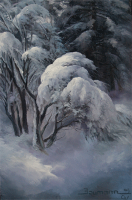Painting is a Memory Exercise by Stefan Baumann
Winter Dogwood
As a steady snowfall covers The Grand View ranch, winter, though late in arriving, is finally here. Dogwood boughs, heavily laden with snow, bend downwards towards the earth. Oak trees struggle to stand upright against the howling, gusty winds. Between the storms, the forest is silent as the deep snow deadens all sounds in the woods. As the season’s storms cross in waves over the great Cascade Range, Mt. Shasta
appears in her majestic winter coat beaming through the dark clouds like a glistening jewel in a royal crown. I am inside, painting what is outside my studio window, but really I am waiting for a moment between storms to put my paintbrush down and hurry outside to shovel snow and free us from the frozen hillside.
This painting, “Winter Dogwood,” is of a view from my studio that I have painted many times in all seasons; but winter is one of my favorites. Earlier today, the storm broke and the morning light beamed across the freshly fallen snow. I painted quickly before the warmth of the light melted the winter’s frozen coat.
Most paintings are in some way created from our memory, and if we paint on location, what we are really doing is painting what we remember. If we could control the environment, we would have little problem recreating our experiences; but the subject is continually changing every moment while we are applying paint to canvas. Light and shadows change, and the subjects reveal new and different insights and appearances as the minutes pass by.
We must observe what is transforming before our eyes without attaching too firmly to each changing aspect of what we see. An artist must rely on their memory of what the location looked like in the moment that he or she started painting it, rather than paint what it becomes. For example, when I started “Winter Dogwood,” the storm had just lifted. For an instant, a ray of sun light beamed through the clouds crossing the forest and catching the edges of the freshly fallen snow. Most of the branches were hidden from view by the snow itself and the background trees were black against the white snow. This painting took about two hours to paint and during that time, the snow melted off the branches and the dogwood trunks bounced back to their vertical position. I wanted to capture the moment when winter had just blanketed the forest, and I had to rely on my memory to recall what it looked like at that moment when I started painting. I painted the layout of the landscape during the original moments of inspiration, as well as the color references that I noted and committed to memory. As I went along creating this work of art, the overall impression came from the memory of what it first looked and felt like to me.


